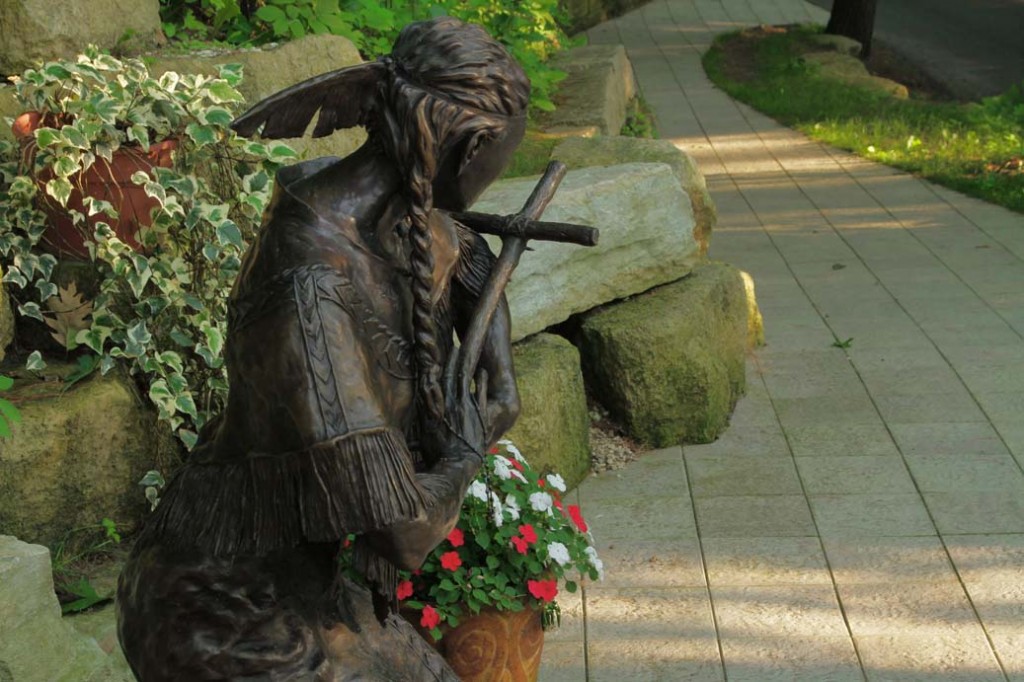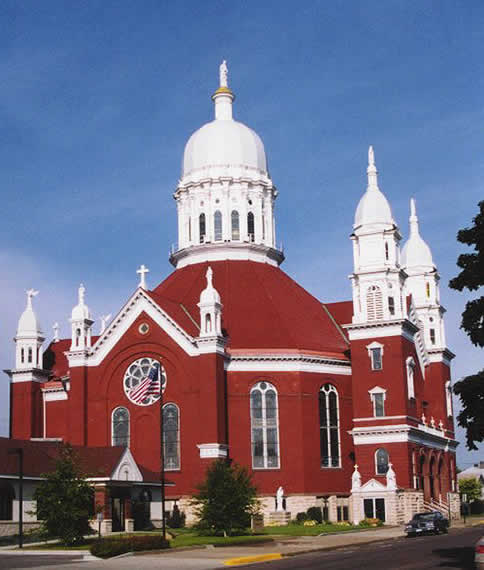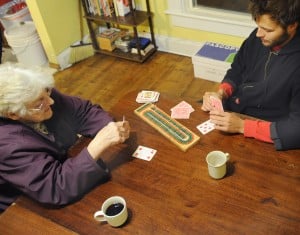The Guild of Catholic Women left St. Paul much the same way it arrived - quietly, and with the good of the community in mind.
No fanfare or proclamations announced its end. Just a final gathering of about 50 women at the same Summit Avenue church where the organization began more than a century ago.
"I guess you could say that we came around full circle," President Alison Enestvedt said of the send-off at the Catholic Community of St. Thomas More, formerly known as St. Luke's.
In late October, the Guild's board of directors, citing an aging membership and declining numbers, voted to dissolve the organization that since 1906 has offered care to St. Paul's needy. The nonprofit leaves behind two endowment funds totaling more than $800,000, which will be distributed to community organizations.
Throughout its history, the Guild served the community. It worked to set up temporary housing for poor immigrant women, established a church for Mexican immigrants and more recently helped those with mental illness.
The Guild's volunteer work over the past century is woven into St. Paul's social fabric.
Its members helped establish a number of existing agencies, including the Bureau of Catholic Charities (the forerunner to today's local Catholic Charities), Our Lady of Peace Home for adults with incurable cancer and Guild Inc., which provides housing and counseling services for people with mental illness.
"They saw a need and responded to them faithfully for 106
years," said the Rev. Joe Weiss of St. Thomas More. "That's their legacy. And that's a glorious thing."
CHANGING ROLES OF WOMEN
Disbanding was a decision not taken lightly, Enestvedt said. But for several decades, the Guild struggled to attract new members and get those they had to step into leadership roles, she said.
"No one wanted to close it; everyone just wanted to keep it going on forever," she said. "But everybody who was involved had every job imaginable."
Like many volunteer organizations, the Guild was affected by the changing roles of women. Women who began working outside the home suddenly were too busy to commit to the group's charity work, Enestvedt said.
So numbers shrank. In the 1970s and early '80s, membership consistently flirted near 1,000. At its end, the Guild had about 200 members, about half actively involved.
"A lot of them are older than I am," Enestvedt said. "And I'm on Medicare."
In 2006, for its 100th anniversary, the Guild tried to stem the tide by focusing on children's and adolescents' mental health problems, such as eating disorders. A task force was also set up to look at its future.
"The things we tried just didn't generate the number of members and the kind of members we needed," Enestvedt said.
GENERATION PASSED OVER
JoAnne Dunn, the interim executive director of the National Council of Catholic Women, is all too familiar with the Guild's plight. The Arlington, Va.-based organization has more than 4,000 affiliated Catholic women's organizations in parishes and dioceses throughout the United States, down from 12,000 in the 1970s.
Some groups waited too long to address declining membership, and some didn't embrace younger women, she said. As a result, an entire generation was passed over, and now current members are aging.
"The St. Paul group and those in other cities did all this great work wholeheartedly for so many years and were very successful," she said. "But while they were doing this, they sort of forgot about the fact they had to keep their eye on their own organization."
And while Dunn acknowledged that women entering the workforce played a part in the national slide, she also pointed to church consolidations and closures, as well as changes in volunteering, as factors.
"The structural organizations that used to exist are changing, and there's been a growth of many parishes of very active social ministry groups, so the traditional women's groups are kind of going out of favor," she said. "I mean, anybody that's under 70 really doesn't want to go to a monthly meeting. And they're not engaged about the idea of decorating an altar."
So two years ago, the group started a drive to focus on younger women and black and Hispanic women, she said, "because they're the fastest-growing population in the church."

Tim Sanders, left, and Eileen Ward string lights on a Christmas tree at the Guild Inc. office. The Guild of Catholic Women established the agency in 1990 to manage direct services to about 100 people with mental illness; today, it serves about 850.
The national organization is hoping to attract younger Catholic women through social networking websites. It is also working closely with the U.S. Conference of Catholic Bishops and other organizations such as Catholic Charities, Catholic Relief Services and the Society of St. Vincent DePaul.
"Everyone knows we have to reach down into the younger generation," Dunn said. "It's going to be a challenge, but I think there's potential."
THE GRAND GALA
Recruiting volunteers was simpler in the early years.
Often, members would invite friends and neighbors over for a silver tea - with the goal of getting them to join and maybe even throw a donation into a silver bowl placed in the middle of the table.
"These were ladies who by and large had the means - they were fairly rich - and had working husbands so they could volunteer and have the teas in the afternoon," recalled Fred Kueppers Jr., the Guild's longtime attorney whose mother served as president in the 1930s. "Those were great days, and I remember them fondly."
Beginning in 1917, most of the Guild's projects were funded with proceeds from its annual charity ball, where members' daughters were "introduced" in a grand march. The last ball was in 1991, but for decades, the gathering was one of the most important events in St. Paul's Roman Catholic community.
Girls who attended St. Joseph's Academy, Derham Hall, Visitation Convent and Our Lady of Peace schools danced at the gala events, escorted by cadets from St. Thomas Academy and Cretin High School.
"They lined you up by height, and that was your date for the evening," said Enestvedt, whose four children participated in the event. "They were something else - they raised a lot of money and helped raise the awareness of doing something for the charity."
Proceeds from the first ball, held at the St. Paul Hotel, helped support the Guild's Nelson Street (now Marshall Avenue) home for young working women who came to St. Paul to work. The gala also helped members launch the original Catholic Infant Home, which later became known as the Seton House, in St. Paul's Rondo neighborhood.
In 1930, when Guild members discovered that Mexican families were not receiving their sacraments, they turned a storefront at Wabasha Street and Fillmore Avenue on St. Paul's West Side into a chapel for hundreds of Mexican immigrants. It was the modest beginning of Our Lady of Guadalupe parish.
"The Mexican community of the West Side Flats had their own chapel," reads a church narrative written in 2006 to mark the 75th anniversary of the parish. "There were smiles all around and tears of joy."
During World War II, like the earlier war, the Guild stayed busy serving the needs of veterans.
In 1964, the Guild's Marshall Avenue property was sold to make room for St. Paul Technical College (now St. Paul College) and the Guild used money from the sale and a donation drive to buy land across the street and open a hall for young working women. In the 1970s, when this type of supervised living facility was no longer in demand, the women focused on providing housing for elderly women on limited incomes.
"They were just superior at finding a cause, putting their heads together, digging in and doing what it takes to get a certain objective achieved," Kueppers said.
A NEW CAUSE
The mid-'70s brought a new cause for the Guild that members would carry on for the next four decades.
For many years, state hospitals for the mentally ill had been closing. In 1974, Ramsey County Human Services asked the organization to provide a boarding home for people with mental illness. Once again, the Guild stepped up, buying an apartment building on Marshall Avenue.
In the early 1980s, at Dakota County's request, the organization bought three homes in South St. Paul and turned them into temporary residential housing for people with mental illnesses.
By 1990, many mentally ill people were getting medication and receiving financial aid from government programs. Helping them became too complicated for the volunteer organization, and the Guild established Guild Inc. to manage direct services to clients.
As part of its centennial year of 2006, the women of the Guild of Catholic Women decided there was a need to better educate the public about mental illness. They began a series of talks, known as "The Puzzle of Mental Illness," with speakers such as mental health advocates Kathy Cronkite, daughter of Walter Cronkite, and actress Carrie Fisher. The talks drew hundreds.
"They were very much at the forefront of serving people with mental illness in the community and opening their arms to welcome them into the community," said Guild Inc. President Grace Tangjerd Schmitt. "And that's characteristic of them throughout their history - always responsive to the needs of the community."
Meanwhile, the demand for Guild Inc.'s services continues to grow.
Last month, as the agency opened an office in Minneapolis, it was named the Provider of the Year by the National Alliance on Mental Illness.
"In 1990, when we were formed, we served about 100 people, and now on any given day we're serving about 850 people," Tangjerd Schmitt said.
The agency will continue to reap the rewards from the Guild's work in the form of a $630,000 endowment.
A second endowment of nearly $200,000, which came from the sale of the Guild's office building in West St. Paul, will be given to organizations that promote "wellness in the community."
Nick Ferraro can be reached at 651-228-2173. Follow him at twitter.com/NickFerraroPP.
A BRIEF HISTORY OF THE GUILD OF CATHOLIC WOMEN
1906: Guild of Catholic Women is founded in St. Paul by Caroline Beaumont and Mrs. J.W. Bishop; consists of 30 women from St. Luke's parish who help the needy by creating food baskets and organizing sewing groups and language and catechism classes.
1908: The Guild opens a local branch of Traveler's Aid Bureau to help immigrants.
1910: Organization places 173 young women in jobs after visiting juvenile court.
1911: YWCA asks the Guild to establish a boarding house at 574 St. Peter St. for young women employed in the city.
1915: Guild members conduct 600 home visits as part of their work with the juvenile court department.
1916: Organization buys a home at 215 Nelson St. (now Marshall Avenue).
1917: Guild hosts its first charity ball in St. Paul at the St. Paul Hotel; proceeds help support the home for young women and the original Catholic Infant Home at Dale Street and Rondo Avenue (later Seton House).
1914-18: Guild promotes Liberty Bonds during World War I, assists veterans and arranges burials for indigent soldiers.
1920: Guild assists in establishment of a Bureau of Catholic Charities, forerunner to today's Catholic Charities; works to have a female physician named to the Minnesota State Board of Health.
1925-30: First Guild Hall to house young working women opens on a lot adjacent to 215 Nelson St.
1930s: Guild transforms a grocery store on the West Side into a chapel for Mexican immigrants, marking the beginning of Our Lady of Guadalupe parish; active in Community Chest, Red Cross, Home of the Good Shepherd, Little Sisters of the Poor, Ramsey County Home for Girls.
1941: Guild assists Dominican Sisters in establishing Our Lady of Good Counsel Home for people with incurable cancer.
1964: Guild sells property at 215 Marshall Ave., buys land across the street at 286 Marshall Ave., where Guild Hall is erected to provide supervised housing for young women. (The building later housed elderly women.)
1974: Ramsey County Human Services asks Guild to provide a boarding and care home for people with mental illness. Purchases 14-unit apartment building at 268 Marshall Ave.; 86 mentally ill people move into vacant Guild Hall.
1983: Dakota County requests services for housing people with mental illness; Guild buys three homes in South St. Paul that are rehabbed and furnished, known as Guild South.
1990: Guild establishes Guild Residence Inc. (now Guild Inc.) as a nonprofit subsidiary to manage direct services to people with mental illness.
1994: Guild sells Guild Hall and apartment building at 268 Marshall Ave. to comply with new government regulations; shifts focus to provide support for people with mental illness to live independently.
1994: Guild buys building at 1025 Dodd Road, West St. Paul, as headquarters.
2006: Guild celebrates "a century of caring community connections."
2011: Guild disbands, establishes two endowment funds.
























